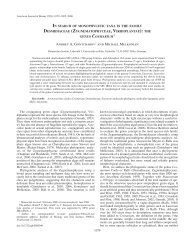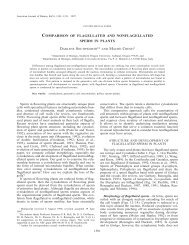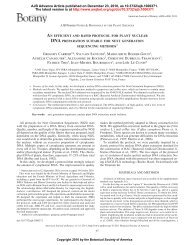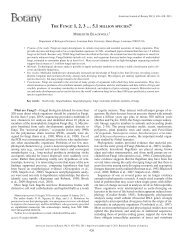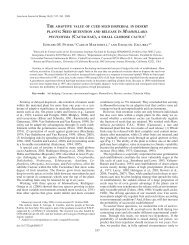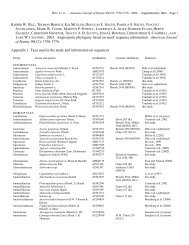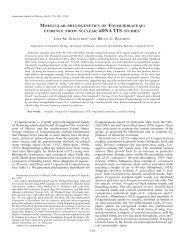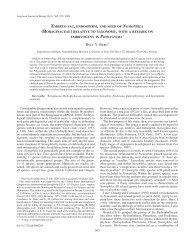View - American Journal of Botany
View - American Journal of Botany
View - American Journal of Botany
You also want an ePaper? Increase the reach of your titles
YUMPU automatically turns print PDFs into web optimized ePapers that Google loves.
September 1999] KRON ET AL.—PHYLOGENETICS OF ANDROMEDEAE<br />
1295<br />
Fig. 1. Strict consensus <strong>of</strong> all most parsimonious trees (36) from<br />
analysis <strong>of</strong> morphological data. Length (L) 139, Consistency Index<br />
(CI) 0.48, Retention Index (RI) 0.68. Decay values are below lines.<br />
Taxa traditionally placed in the tribe Andromedeae are in boldface.<br />
strongly supported by the data. Within this clade Vaccinieae<br />
are monophyletic and form a polytomy with three<br />
other clades. The sister relationship <strong>of</strong> Andromeda polifolia<br />
and Zenobia pulverulenta is strongly supported by<br />
the matK data and there is strong support for Chamaedaphne<br />
calyculata sister to Leucothoë racemosa. These<br />
results are different from the morphological analysis (Fig.<br />
1) where Andromeda is indicated as more closely related<br />
to the Lyonia group than the Gaultheria group. Similar<br />
to the morphological analysis, Lyonia and Pieris are<br />
monophyletic in the matK analysis. The Lyonia group<br />
(Lyonia, Craibiodendron, Pieris, Agarista) is monophyletic<br />
but not very strongly supported. In both the rbcL<br />
and matK analyses the Gaultheria group is placed in the<br />
same clade with a monophyletic Vaccinieae. In the matK<br />
analysis this large clade is strongly supported. The results<br />
<strong>of</strong> the rbcL analysis indicate only weak support for a<br />
Gaultheria group Vaccinieae clade, with the clade collapsing<br />
in trees one step longer than most parsimonious<br />
(Fig. 3). The Gaultheria group is not supported as monophyletic<br />
by either the rbcL or the matK analyses. Both<br />
analyses indicate a core Gaultheria clade that includes<br />
Tepuia, Diplycosia, Gaultheria, and Pernettya. In the<br />
rbcL analysis Diplycosia is sister to Tepuia, whereas in<br />
the matK analysis Diplycosia is included in a polytomy<br />
containing Gaultheria and Pernettya. However, none <strong>of</strong><br />
these relationships is strongly supported in either analysis.<br />
Combined analysis <strong>of</strong> rbcL and matK data resulted in<br />
four most parsimonious trees (L 1495, CI 0.92, RI<br />
0.58). The strict consensus (Fig. 5) is highly resolved<br />
with Oxydendrum sister to the remaining ingroup taxa.<br />
As in the separate molecular data analyses Agarista,<br />
Lyonia, and Pieris are monophyletic, but in the combined<br />
analysis they each have higher levels <strong>of</strong> support than in<br />
each individual analysis. In the combined rbcL and matK<br />
analysis Vaccinieae are monophyletic and unresolved<br />
with respect to the Andromeda Zenobia clade and the<br />
weakly supported clade that includes Leucothoë, Chamaedaphne,<br />
Tepuia, Diplycosia, Gaultheria, and Pernettya.<br />
In this analysis Gaultheria is paraphyletic with respect<br />
to Pernettya, a relationship also found in the rbcL<br />
and morphological analyses.<br />
Combined molecular and morphological analysis—<br />
This analysis resulted in the generation <strong>of</strong> a single most<br />
parsimonious tree <strong>of</strong> 1565 steps, a consistency index (CI)<br />
<strong>of</strong> 0.61, and a retention index (RI) <strong>of</strong> 0.59 (Fig. 6). The<br />
position <strong>of</strong> Oxydendrum as sister to the remaining ingroup<br />
taxa is strongly supported.<br />
The monophyly <strong>of</strong> the Lyonia group (incl. Agarista,<br />
Craibiodendron, Lyonia, and Pieris) is strongly supported<br />
(d8, 99% bootstrap). Noteworthy morphological features<br />
supportive <strong>of</strong> the monophyly <strong>of</strong> this group include<br />
bands <strong>of</strong> fibers in the phloem (no. 1), leaves with lignified<br />
epidermal cells (no. 13), S-shaped filaments (no. 33), and<br />
more or less elongated testa cells (no. 57). Within this<br />
clade, Agarista likely is sister to Pieris, and Craibiodendron<br />
is weakly supported as the sister group <strong>of</strong> Lyonia.<br />
Agarista, Pieris, and Lyonia are all strongly supported<br />
as monophyletic (Fig. 6); the monophyly <strong>of</strong> Craibiodendron<br />
was not assessed. Cladogram topology within<br />
the Lyonia group was identical to that discovered in our<br />
previous analysis <strong>of</strong> this group (Kron and Judd, 1997),<br />
and that paper should be consulted for a more detailed<br />
discussion <strong>of</strong> these generic and infrageneric relationships.<br />
Vaccinieae form a well-supported clade (d24, 100%<br />
bootstrap) with members <strong>of</strong> the Gaultheria group, Andromeda,<br />
and Chamaedaphne. A significant morphological<br />
synapomorphy <strong>of</strong> this clade is paracytic stomata (no.<br />
20). The Vaccinieae are clearly monophlyetic (d19, 100%<br />
bootstrap) and are supported by the same morphological<br />
characters as in the morphology-based analyses, with the<br />
addition <strong>of</strong> the anther tubules (no. 41). Such tubules evidently<br />
have evolved independently in a few other taxa,<br />
e.g., Chamaedaphne and the Tepuia Diplycosia clade.<br />
The remaining taxa, mainly members <strong>of</strong> the Gaultheria<br />
group, form a very weakly supported clade (d1, 50%<br />
bootstrap), which possibly is supported by the synapomorphy<br />
<strong>of</strong> a base chromosome number <strong>of</strong> 11 (although<br />
Andromeda has x 12). In addition, forked appendages<br />
(no. 40) occur on the anthers <strong>of</strong> Zenobia, Gaultheria, and<br />
Pernettya and may have been lost from the remaining<br />
taxa. Within this group, Andromeda and Zenobia are sister<br />
to a potential clade (d1, 63% bootstrap) containing<br />
Chamaedaphne, Leucothoë, Tepuia, Diplycosia, Gaultheria,<br />
and Pernettya. However, a core element, containing<br />
Diplycosia, Tepuia, Gaultheria, and Pernettya is well<br />
supported (d11, 100% bootstrap). Members <strong>of</strong> this clade<br />
are united by the presence <strong>of</strong> methyl salicylate (lost in<br />
some species <strong>of</strong> Gaultheria and Diplycosia). They may<br />
also share the apomorphy <strong>of</strong> sepals that are fleshy and<br />
colorful, but the latter feature is absent in Tepuia (and in<br />
some species <strong>of</strong> Pernettya) and may have evolved inde-



